Related Research Articles
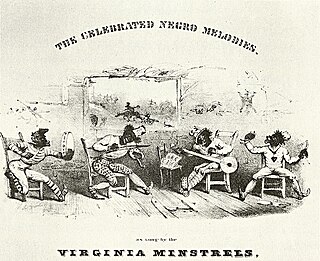
The minstrel show, also called minstrelsy, was an American form of racist entertainment developed in the early 19th century. Each show consisted of comic skits, variety acts, dancing, and music performances that depicted people specifically of African descent. The shows were performed by mostly white people in make-up or blackface for the purpose of playing the role of black people. There were also some African-American performers and black-only minstrel groups that formed and toured. Minstrel shows lampooned black people as dim-witted, lazy, buffoonish, superstitious, and happy-go-lucky.

The Virginia Minstrels or Virginia Serenaders was a group of 19th-century American entertainers who helped invent the entertainment form known as the minstrel show. Led by Dan Emmett, the original lineup consisted of Emmett, Billy Whitlock, Dick Pelham, and Frank Brower.

Daniel Decatur Emmett was an American songwriter, entertainer, and founder of the first troupe of the blackface minstrel tradition, the Virginia Minstrels. He is most remembered as the composer of the song "Dixie".

"Old Dan Tucker," also known as "Ole Dan Tucker," "Dan Tucker," and other variants, is an American popular song. Its origins remain obscure; the tune may have come from oral tradition, and the words may have been written by songwriter and performer Dan Emmett. The blackface troupe the Virginia Minstrels popularized "Old Dan Tucker" in 1843, and it quickly became a minstrel hit, behind only "Miss Lucy Long" and "Mary Blane" in popularity during the antebellum period. "Old Dan Tucker" entered the folk vernacular around the same time. Today it is a bluegrass and country music standard. It is no. 390 in the Roud Folk Song Index.
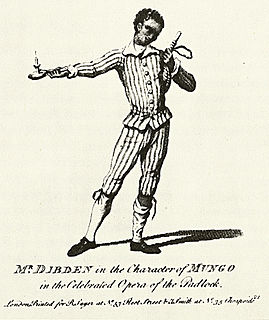
The Padlock is a two-act 'afterpiece' opera by Charles Dibdin. The text was by Isaac Bickerstaffe. It debuted in 1768 at the Drury Lane Theatre in London as a companion piece to The Earl of Warwick. It partnered other plays before a run of six performances in tandem with The Fatal Discovery by John Home. "The Padlock" was a success, largely due to Dibdin's portrayal of Mungo, a blackface caricature of a black servant from the West Indies. The company took the production to the United States the next year, where a portrayal by Lewis Hallam, Jr. as Mungo met with even greater accolades. The libretto was first published in London in 1768 (?) and in Dublin in 1775. The play remained in regular circulation in the U.S. as late as 1843. It was revived by the Old Vic Company in London and on tour in the UK in 1979 in a new orchestration by Don Fraser and played in a double-bill with Garrick's Miss In Her Teens. The role of Mungo was, again, played by a white actor. Opera Theatre of Chicago have recently revived the piece (2007?) where, it would seem, the role of Mungo was changed to that of an Irish servant.
Bryant's Minstrels was a blackface minstrel troupe that performed in the mid-19th century, primarily in New York City. The troupe was led by the O'Neill brothers from upstate New York, who took the stage name Bryant.
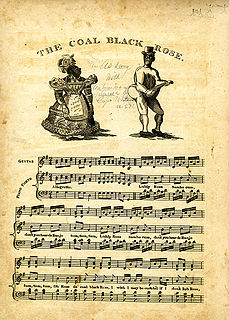
"Coal Black Rose" is a folk song, one of the earliest songs to be sung by a man in blackface. The man dressed as an overweight and overdressed black woman, who was found unattractive and masculine-looking. The song was first performed in the United States in the late 1820s, possibly by George Washington Dixon. It was certainly Dixon who popularized the song when he put on three blackface performances at the Bowery Theatre, the Chatham Garden Theatre, and the Park Theatre in late July 1829. These shows also propelled Dixon to stardom.

Buckley's Serenaders was a family troupe of English-born American blackface minstrels, established under that name in 1853 by James Buckley. They became one of the two most popular companies in the U.S. from the mid-1850s to the 1860s, the other being the Christy and Wood Minstrels.
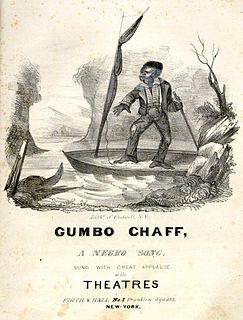
"Gumbo Chaff", also spelled "Gombo Chaff", is an American song, first performed in the early 1830s. It was part of the repertoire of early blackface performers, including Thomas D. Rice and George Washington Dixon.
"Clare de Kitchen" is an American song from the blackface minstrel tradition. It dates to 1832, when blackface performers such as George Nichols, Thomas D. Rice, and George Washington Dixon began to sing it. These performers and American writers such as T. Allston Brown traced the song's origins to black riverboatsmen. "Clare de Kitchen" became very popular, and performers sometimes sang the lyrics of "Blue Tail Fly" to its tune.
"De Wild Goose-Nation" is an American song composed by blackface minstrel performer Dan Emmett.
"Walk Along John", also known as "Oh, Come Along John", is an American song written for the blackface minstrel show stage in 1843. The lyrics of the song are typical of those of the early minstrel show. They are largely nonsense about a black man who boasts about his exploits.
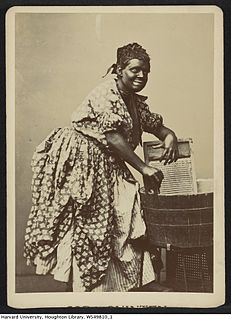
Sanford's Opera Troupe was an American blackface minstrel troupe headed by Samuel S. Sanford (1821-1905). The troupe began in 1853 under the name Sanford's Minstrels. The name changed that same year to Sanford's Opera Troupe. The lineup changed in 1856 and again in 1857, when they disbanded.
"Miss Lucy Long", also known as "Lucy Long" as well as by other variants, is an American song that was popularized in the blackface minstrel show.

Charles H. Keith was an American music publisher in Boston, Massachusetts in the 19th century. His business was located on Court Street from the 1840s to the 1850s. Among the songs published by his firm were "Old Dan Tucker" (1843), "Ole Bull and Old Dan Tucker" (1844), and "Dandy Jim ob Caroline" (1844).

Francis Marion Brower was an American blackface performer active in the mid-19th century. Brower began performing blackface song-and-dance acts in circuses and variety shows when he was 13. He eventually introduced the bones to his act, helping to popularize it as a blackface instrument. Brower teamed with various other performers, forming his longest association with banjoist Dan Emmett beginning in 1841. Brower earned a reputation as a gifted dancer. In 1842, Brower and Emmett moved to New York City. They were out of work by January 1843, when they teamed up with Billy Whitlock and Richard Pelham to form the Virginia Minstrels. The group was the first to perform a full minstrel show as a complete evening's entertainment. Brower pioneered the role of the endman.
"Mary Blane", also known as "Mary Blain" and other variants, is an American song that was popularized in the blackface minstrel show. Several different versions are known, but all feature a male protagonist singing of his lover Mary Blane, her abduction, and eventual death. "Mary Blane" was by far the most popular female captivity song in antebellum minstrelsy.

John Diamond, aka Jack or Johnny, was an Irish-American dancer and blackface minstrel performer. Diamond entered show business at age 17 and soon came to the attention of circus promoter P. T. Barnum. In less than a year, Diamond and Barnum had a falling-out, and Diamond left to perform with other blackface performers. Diamond's dance style merged elements of English, Irish, and African dance. For the most part, he performed in blackface and sang popular minstrel tunes or accompanied a singer or instrumentalist. Diamond's movements emphasized lower-body movements and rapid footwork with little movement above the waist.
References
- Mahar, William J. (1999). Behind the Burnt Cork Mask: Early Blackface Minstrelsy and Antebellum American Popular Culture. Chicago: University of Illinois Press.
- Winans, Robert B. (1996). "Early Minstrel Show Music, 1843–1852". Inside the Minstrel Mask: Readings in Nineteenth-Century Blackface Minstrelsy. Hanover, New Hampshire: Wesleyan University Press.